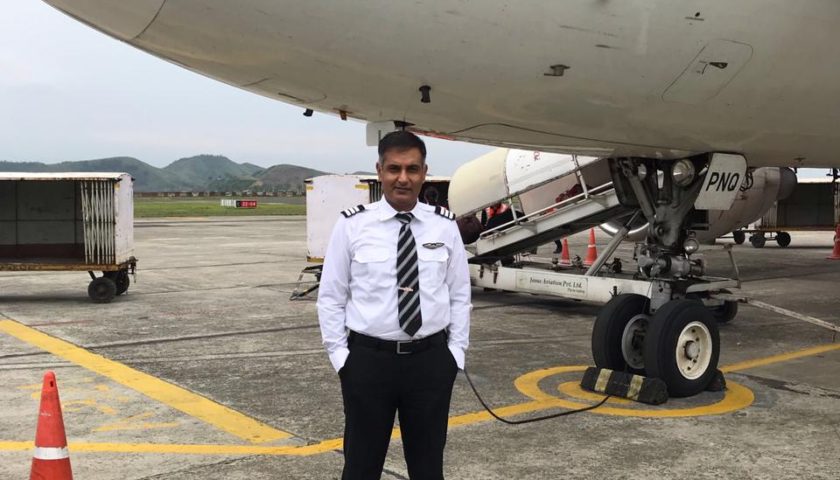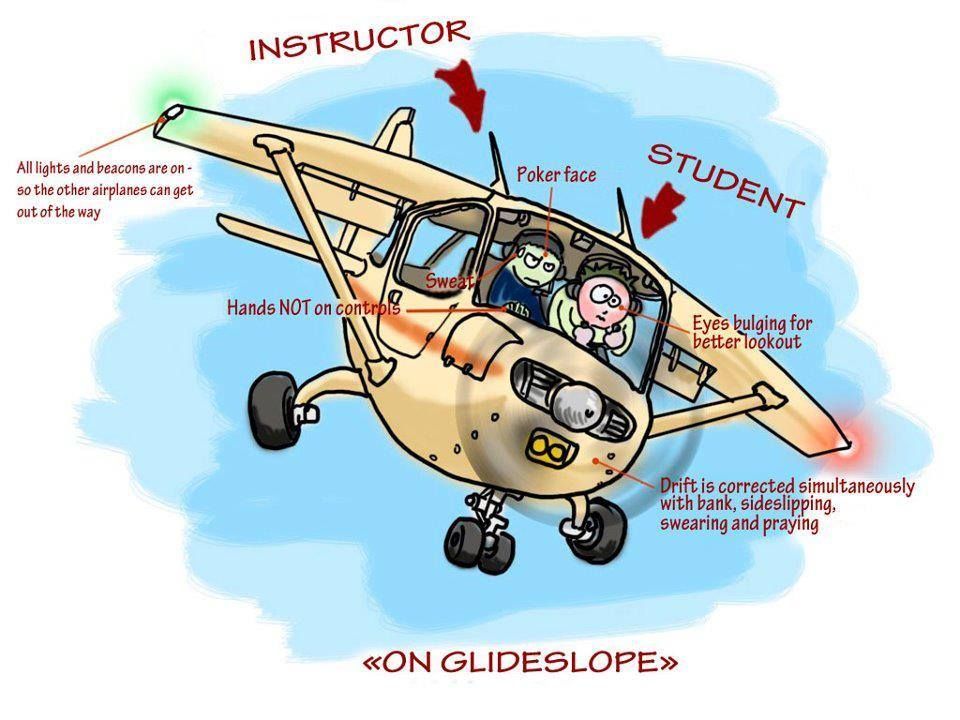A pilot’s journey begins with a dream,
shaped by a flight instructor.
A flight instructor
who believes in you,
who fills winds in your sail,
who lights the fire,
and shapes your dream with feedback (truth)
employing a medium of communication which touches the heart, mind and spirit.
Teaching imparts knowledge and instructing imparts skills. Therefore a teacher is one who teaches you about a subject and helps you reach understanding and an instructor is one who instructs you on how to accomplish a task. In reality, quality learning experiences are not simply one or the other, they are a blend of the two. A good teacher will help you to do things with your new knowledge and a good instructor will help you understand what you are doing with a bit of theory.
I cannot emphasize enough the importance of a good flight instructor. With this as a topic, we will today meet one of the best instructors who will explain the importance as well as the best qualities to look out for in a flight instructor.

- Anurag, you had been Directing Staff at Indian Air Force Flight Instructor School, Tambaram. Tell us something about the school, it’s history, role, and aim?
Ans. The Royal Indian Air Force played a major role in the Burma sector during WW II and the forefathers of independent Indian Air Force were very clear about the role of Air Power in general and an independent Air Force in particular. Further, the role played by Indian Air Force in saving Srinagar and J&K from the Pakistani infiltrators cemented the fact that a strong Indian Air Force (IAF) was a necessity. A strong Air Force requires professional pilots and good professional pilots require sound training. Thus, on the first Air Force Raising Day, 01 Apr 1948 (as it was celebrated until the late 1970s), Flying Instructors School (FIS) was formed at Ambala with Flt Lt LRD Blunt (‘Screamy’) as the first Commanding Officer. In the initial years, it was a humble beginning with 5-6 pilots being trained to become a Qualified Flying Instructor (QFI) every course on Tiger Moth and Harvard ac in a period of 12 weeks. In 1954, the developing threat scenario in the subcontinent forced many strategic changes in the IAF and FIS was relocated from Ambala to AF Station Tambaram near Chennai. FIS was reequipped with the indigenous trainer HT-2 in 1954 that continued in service till 1989 and HJT-16, Kiran (the HAL built jet trainer) in 1971 and it is still in service at FIS. The FIS has proudly completed 72 glorious years in the service of the Nation.
- What is the moto of school and how does it translate to standard of training in military aviation?
Ans. The motto of FIS is “VIDYA DANEN VARDHATE”. Derived from Chanakya’s ‘ARTHASATRA’ it implies that ‘Knowledge, when imparted, multiplies’. It is the guiding principle of the teaching-learning process at the Flying Instructors’ School and from my experience, I can vouch for it. Being an instructor has been the greatest learning experience of my aviation life.
A flying instructor finds the greatest satisfaction when the pupil surpasses his instructor. So as much as the trainee wants to learn from his/her Guru, the instructor wants to impart all the knowledge to his trainee. Their success is the greatest source of satisfaction and the desire to impart the best knowledge to the trainee silently makes the instructor better. “The child is the father of the man” applies very aptly to the Pupil-Instructor relationship as well.
- How did the training at National Defence Academy, Air force Academy and at operational units help you become a better pilot and instructor?
Ans. Warfighting is a serious profession. It’s your life or the enemy’s life that will win or lose the war. The most important trait of a soldier is his character that is defined by the mental strength to do the right things even when his/her life is in peril. From a military pilot’s perspective, the training at National Defence Academy strengthens the budding pilots mentally and gives them an understanding of the other sister services (army and navy) to appreciate what the role of a military pilot is expected to be. Air Force Academy is more focussed on imparting flying training and the whole curriculum revolves around a very busy flying schedule. During flying training, the trainees live every moment in excitement, fear and stress. Most people who chose to become a pilot are chasing a dream and the pain of a shattered dream is very stressful. Each trainee has a different mental makeup and even though, the standardised training at NDA, the Pre-Flying Training Centre (PFTC) for those joining after graduation gives them a common mental makeup, still, each one reacts differently to training instructions, stress and flying in general. The Instructor has to read the mind of the trainee to understand the stress, fears and challenges that each pupil is experiencing and then assist him/her to overcome them while chasing their dreams. As an instructor, when you have faced similar challenges in your early days and have a clear understanding of the organisational requirements, half the battle is won. It definitely makes you a better instructor.

- What is the kind of training does a budding instructor undergo to professional instructor pilot? Tell us something about the schedule, syllabus, flying training and other roles performed by FIS?
Ans. From a 12-week curriculum at inception, the FIS course has now expanded to a 24-week curriculum. The basic aim of the course is to transform an operational pilot into a professional instructor. The basic tenets of an instructor are
- Knowledge and Skill. To demonstrate a good manoeuvre, one must be skilful and knowledgeable to get it right almost every time. Many trainees respond to a good demonstration and can replicate what you show them. If you do it wrong, chances are that the pupil will learn the wrong thing too. Background knowledge is considered a must for imparting sound flying training. Unless one understands the “Why’ element, it is difficult to master the “what” and “How” parts of each manoeuvre.
- Fault Analysis. Good analytical skills to do critical “fault analysis” and not just fault listing. You have to be able to point out that one mistake that is the root cause of secondary mistakes. Merely listing faults will not help the pupil to become a better pilot. Trainee QFIs are given extensive exposure to likely mistakes that could be made by pupils at various stages of flying and trained to analyse faults correctly both on the ground as well as during a flight.
- Good Communication Skills. You may know the cure for cancer but if you live on an island…. does it really matter? One’s ability to convey the required information in the best possible way and also switch techniques from one to another is an important element of being an instructor. The trainee QFIs conduct classes/lectures, give presentations to develop these skills. A very important aspect of becoming a good instructor is to be able to speak to the trainee in air. It’s called “Patter”. Each manoeuvre has as structured patter that the instructor uses while demonstrating flight manoeuvres in the air. From getting tongue-tied in the initial training flights, the U/T QFIs gradually progress to be able to effectively modifying the patter to convey the requisite key points. The aim is to make the aeroplane do what you want it to do in every manoeuvre you demonstrate. Such is the level of skill expected from an instructor.
Therefore, the course curriculum at FIS is designed precisely to impart/develop skill and knowledge of all budding instructors in these spheres. Handpicked operational pilots are now given a deeper understanding of aviation ground subjects like aerodynamics and aeroplane designs, avionics and instruments, aero-engines and performance, meteorology and most importantly Methods of Instructions. Trainee instructor flies near about 100 training flights with FIS instructors and buddy trainees. From learning to teaching, the trainees go through the complete cycle at FIS.
Needless to say, testing is an important part of the course as well and to ensure requisite standards are always maintained if not improved upon, the trainees are tested in both ground subjects as well as flying. The ratio is almost one test per week or more. The performance in these tests not only governs one’s merit in the course but also impacts their further career progression as a pilot in the IAF. Hence the pressure to perform is intense and the curriculum very strenuous. A military pilot is expected to sustain this pressure over a period of almost six months. Only after getting steeled through this strenuous course will the trainees graduate to become some of the best instructors in the world.
- What are the minimum qualifications to become an instructor and what is the selection criteria?
Ans. The QFI course is a very prestigious course for a pilot and a gateway to further career progression in not only the IAF but for Navy, Army, Coast Guard or friendly foreign forces that also send their pilots to FIS for the course. The selection process involves many criteria as elaborated below: –
- Organizational Requirements. Based on the requirements of IAF/Army/Navy/ICG/Friendly Foreign Forces in various flying streams namely Fighter, Transport and Helicopters, the vacancies are adjusted to fill the demand. It is also limited by the maximum trainees that FIS can effectively absorb. From 5-6 trainees in the initial years, the number of U/T QFIs per course has increased to 60-70 now.
- Merit/ Competence. Operational pilots in usually 6-10 years of service brackets are selected for the course. During this period, the pilots have attained the desired levels of proficiency on their operational aircraft, acquired necessary role qualifications and proven their mettle as good military pilots. By this time, most pilots are in the age group of 28-30 and considered adequately matured to become an instructor. All those pilots who meet the competence criteria are subjected to a merit list and only the best ones selected.
- Aptitude. This is a very important facet of an instructor. Many successful pilots, at times the best, do not necessarily turn out to be the best instructors. Hence Aptitude assessment forms a very important selection criterion. The recommendation of not only the superior commanders but inspecting agencies of the Air Force also governs the selection of the pilot to become an instructor. For those who do not have the aptitude for training follow a different route of career development.

- A flight instructor plays a very vital role in shaping the future of a military aviator. Could you elaborate on the role of an instructor and expectations from him/her?
Ans. When I was a trainee, my instructor was like a God to me and similarly for all my course mates as well. We believed in our instructors so much that everything they did or said was like Gospel to us. We had placed our lives in their hands. That is what becoming a pilot means to every youngster who joins the IAF to become a pilot; its life! So, from there starts a relationship that is bonded forever. One tends to emulate his/her instructor in everything…. the walk, the talk, the manner in which he/she wears the flying gloves or helmet etc. So, the instructor is the role model for the trainee. It is never easy to be a role model. The Instructor has to rise to the occasion. Each instructor bonds in this manner with at least 9-12 trainees during his Instructional tenure at the training academies and practically shapes their foundation. When viewed from the organizational or the individual’s perspective It’s a very important role. The responsibility is enormous!
- After retirement you have been working in commercial aviation as a Captain. How do you compare military instructors vs civil instructors?
Ans. While the basic tenets of Instructional remain the same, there are some distinct variations.
Military Instructor. The military flying envelope encompasses everything that the aeroplane can do and at times even that the aeroplane cannot do. From, basic flying training to air-air refuelling, from air combat to landing a helicopter in Siachen well above the service ceiling, the military instructor has a role to play. From the first-ever flight to operational training on modern advanced aeroplanes like the Rafale, or Apache gunship Helicopter or the C130 Hercules. Military flying is constantly under evolution. Every new technology that the enemy acquires changes the threat scenario and new tactics have to be evolved to outwit the enemy. The roles are vast, hence the training required is very widespread. Needless to say, the instructor has to demonstrate a very high standard. From basic to operational roles to the most advanced operational roles the envelope is vast. Even for the instructor, the learning never stops.
Another important aspect of Military training is that not everyone can become a military pilot. The selection process ensures that only those with the right ingredients make the cut. Hence the training is time-bound and paid for by the Govt of India. The luxury of another training flight is not always available and the training has to be imparted in the requisite time frame and to the desired standards always. The onus of this is as much on the instructor as much on the trainee. Hence the trainers cannot take it easy. If a selected candidate is unable to make the grade, the instructor is held accountable too.
Civil Instructors. In the world of civil aviation also not everyone can become a trainer. The selection process is perhaps as stringent as it is for a military pilot. However, the training capsule for a civil instructor is not as elaborate as it is for a military instructor. The reason is very simple, the roles performed by civil pilots are limited to just one. Route flying from place A to Place B. The ground subjects’ knowledge is tested as a part of licence issuing by the DGCA and subsequently, it becomes a personal agenda for the pilot.

- You have vast experience in training and mentoring, what changes you would like to see in training pattern of civil and military aviation?
Ans. Training is a continuous learning process! As machines change, so do the challenges and the requirements. Therefore, training patterns must be continuously reviewed, evolved and modified to suit the need of the hour. Both civil and military training is evolving to make it safer and better. Greater use of simulators in military flying training and skill-based training in civil flying are things that can perhaps be focussed on a little more.
- What are the most important things to have a successful career in aviation?
Ans. (a) Attitude
(b) Knowledge
(c) Skill

Thanks, Anurag for sharing your experience and knowledge. You have clearly brought out the challenges, requirements and expectations.
Flight Instructor’s job looks simple and easy while you are a pupil pilot. To be a good instructor you need to have extraordinary eyesight for details, enormous patience and cool attitude to teach, a full measure of courage, calculated recklessness to send someone solo and occasional luck. It isn’t always sunshine and rainbow both literally and figuratively. If ever you feel overwhelmed while instructing remember when finally your pupil will have an official pilot certificate in hand, it will be your biggest accomplishment ever.
Brief Bio of our guest writer:
Gp Capt Anurag Sharma, VSM, (Retd) was commissioned into the fighter stream of the Indian Air Force on 18 Dec 1993. During almost 24 years of service, he has flown a variety of fighter and trainer aircraft with Su-30 MKI and Jaguars being his primary aircraft. He has more than 4400 of military flying to his credit. Alumni of NDA, he is a Cat A QFI, an Air Force Examiner on Jaguar and Su-30, commanded a Su-30 MKI Sqn, and was also the Chief Operations Officer of a Su-30 base. He also holds an MSc ( Def Studies) degree from DSSC and an M Phil in Defence strategy from the School of Advanced Air and Space Studies ( SAASS), USAF. Presently he is employed with an Airline as an A-320 Captain.

Related article: My First Air Travel Experience. Click to read.
Related article: My first flight as a trainee pilot (flight cadet). Click to read.



